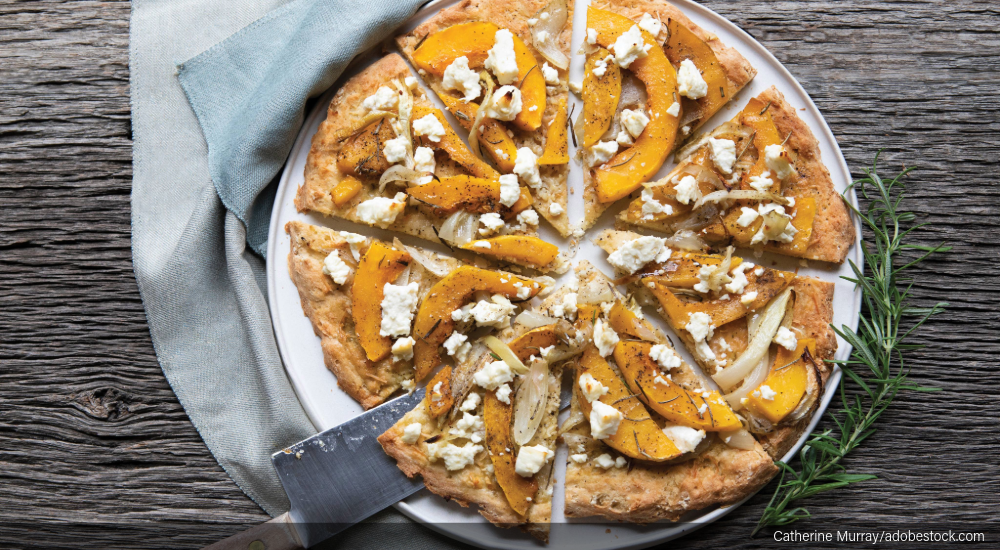Turning winter squash into pizza that’s ‘precioussss’
In or about the year 105 A.D., Iroquoian hunters arrived at their village on a cold, gray evening on the northern bank of the Potagannissing River near Lake Huron. They entered the lodge and were lured to the smoky warmth of the council fire. A large, ceramic cooking pot on the fire escalated the hunters’ hunger and made them gather around an older woman, who was preparing Sagamité, a flavorful stew of boiled hominy meal and pounded whitefish, thickened with acorn flour.
The woman pushed them away while she added the most delicious part of this stew last: thin-skinned winter squash and pumpkin cut into chunks that would add a sweet and nutty flavor to the stew. Today, you’d be hard-pressed to find Sagamite’ in the can – or even in any cookbook – but as restaurant owners and operators, we can all take advantage of the delicious qualities of winter squash in our menu-mix.
Like the Iroquois, civilizations all over the world have been using winter squash for centuries. This productive fall and winter vegetable is mostly native to Mexico and Central America and has been grown since at least 7,000 years before Europeans “discovered” the Americas.
The Japanese love Kabocha squash steamed with sake and white miso or simmered with konbu (an edible kelp), and Brazilians sometimes use it in their national dish, the hearty stew Feijoada. The French in Bordeaux infuse squash into light, sweet cakes called canelés, and Chef Daniel Boulud uses pickled winter squash ribbons in his famous dish of bacon-wrapped monkfish and lobster.
Pasta is a favorite squash partner in Italy, as in the Lombardian gnocchi di zucca e patate. Even the evil-looking Bitter Melon is extensively used in Caribbean and Asian dishes.
Butterwhat? Squash varieties perfect for pizza.
The many varieties of squash and gourds reflect the differing attributes of each. The robust sweetness of winter squash varies as much as the textural density. Fabrication of winter squash is sometimes tough. I’ve cut myself prepping winter squash more than any other vegetable because of the shape, size and slipperiness. Most squash can be roasted until tender. Here are some squash varieties that are perfect for pizza:
1. Delicata
Because of its long, tubular shape and its ability to be baked with its skin on, this wonderful squash just begs to be stuffed. It has a mild, cream colored flesh and sweet potato-like flavor that caramelizes easily. Delicata does not keep as long as other squash varieties, but it does an outstanding job on pizza sliced in rounds.
It pairs with Fontina, Gruyere, apples, coriander cream, garlic, soppressata Friuli salami, pistachio and burrata.
2. Tromboncino
This green, trombone-shaped squash is my new favorite, a creamy Italian heirloom that can be eaten raw, roasted with lemon, maple syrup and vanilla, or even pickled. Tromboncino can be harvested young and tastes like zucchini; left to mature, it will taste nutty and pumpkin-like.
I love this with black currant jam, Manchego and bacon – or even ramped up with thin country ham slices on melting Gruyere.
3. Butternut
Smooth, dense flesh becomes sweet and nutty when baked or steamed. This squash is best skinned before cooking. Select the ones with a thick and long neck, as it takes longer to fabricate the bottom bulb.
Parmigiano, ricotta and goat cheese are good combinations. Onions, parsley, sage, cinnamon and even anchovies meld well with butternut flavor.
4. Acorn
This mild-flavored squash is lightly sweet with firm, yellow-orange flesh. It is annoying to slice into its zig-zag ribbed skin, so sliced once, scoop out the seeds and bake.
This squash is wonderful with Pecorino Romano, Asiago and Manchego.
5. Kabocha
As mentioned above, this squash is lauded for its dense, smooth-textured, slightly dry flesh. It has a flavor reminiscent of chestnuts with just a hint of sweetness.
This squash is very complementary with salty-savory items such as Prosciutto di Parma, nuts and green apples. Fior di latte mozzarella, maple syrup and crème fraiche also are good pairings.
6. Spaghetti
This is more celebrity than a “go-to” squash for pizza because it tends to turn to mush when heated. I highly recommend using the baked flesh after the oven.
Chicken, duck, bacon, tomatoes, vinaigrettes, oregano, gorgonzola, feta, bell peppers and Parmigiano are good pairings.
7. North Georgia Candy Roaster
This monster is by far the best bang for the buck in squashland. The Cherokee tribe gave the public seeds that had been kept secret for years. This squash gets sweeter in storage and can keep up to six months.
This squash has a more honey-maple flavor and is brilliant with pecan, black walnut and even toasted hazelnuts.
Any way you use winter squash, it can be a very nice bridge from savory and salty to sweet and nutty.
Here are some more pairings worth trying with winter squash: chili powder, cumin, caraway, mushrooms, lamb, thyme, rosemary, radicchio, paprika, parsley, curry, lemongrass, apples, celery leaves, capicola, pork, leeks, pears, lime juice, mustard, ginger, mortadella, potatoes, sour cream and tarragon.
JOHN GUTEKANST owns Avalanche Pizza in Athens, Ohio.
 Read the November 2025 Issue of Pizza Today Magazine
Read the November 2025 Issue of Pizza Today Magazine
This month, we are diving deep on all things cheese. Learn how the fluctuating commodities market can impact the price you pay for mozzarella and other block cheeses. Then, find out how operators are using craft beer cheddar, gorgonzola and plant-based cheeses made from cashews, coconuts, peas and other bases to create pizzas that are visually and gastronomically stunning. Round out your education for the month by brushing up on pizzeria art, SOPs and winter squash.
Check out the full Digital Edition – Pizza Today November 2025.



